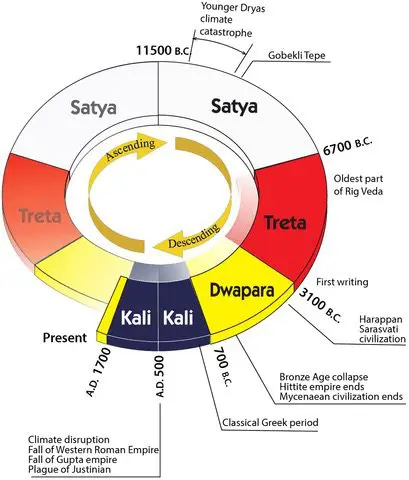-
NoraSpinnor posted an update in the group
 Astrology & Celestial Cycles 5 months, 1 week ago The Yuga Cycles:
Astrology & Celestial Cycles 5 months, 1 week ago The Yuga Cycles:
Our Rise from Kali to DwaparaAbsolutely everything cycles. We are most familiar with smaller cycles: yearly shifts with the seasons, moon cycles, and life cycles. Human consciousness also cycles. Netism teaches that human history reaches much further back than commonly believed. The ancients spoke of a decline of great wisdom. This decline has happened over the course of thousands of years. For the last two thousand years, we have been in the Dark Ages, a period characterized by a strict ruling class and spiritual isolation. We are now on the ascent. We are at a time of crisis, but people are waking up. Ancient secrets are being revived through inspired minds tapped into the Net.
If we determine the timeline of Kali Yuga to end in the year 1700, after a 200-year transition period, we entered fully into Dwapara in 1900. The signs are all around us—an explosion of technology, a growing awareness of energy and consciousness, and a breakdown of centralized control. What once belonged only to sages and initiates is now becoming accessible to anyone willing to seek. We aren’t discovering new concepts; we are remembering them.
In Netism, we recognize the Yuga cycles as a map that shows us where we’ve been, where we are, and where we’re headed. They offer hope for a brighter future and remind us to have humility. We are far from the Golden Age, and the remnants left by our most ancient ancestors can teach us a great deal if we are willing to listen.An overview of the cycles:
Kali: The Age of DarknessIn Kali Yuga, spiritual growth is difficult. Wealth is primarily contained within monarchies or elite classes, while the rest of the population has little to no opportunity for financial gain. After a 200-year transition period, this age began in 700 B.C.E., marked by a global collapse of higher wisdom traditions and the rise of material empires. In India, the Vedic knowledge began to wane, and formal caste divisions hardened. In the Near East, the Neo-Assyrian Empire reached its peak of militaristic control. In Greece, the Homeric epics emerged, signaling a shift from oral mysticism to written philosophy, while the spiritual depth of earlier matriarchal cultures faded. The Hebrew kingdoms fractured into exile and diaspora. In China, the Zhou Dynasty declined into chaos, leading to the Warring States period. Across the world, sacred kingship gave way to authoritarian rule, and divine science was increasingly hidden or lost. These events signaled the darkening of the world’s cycle—the entrance into the Iron Age of consciousness, where materialism and ignorance dominate. It ended around the year 1700, followed by a 200-year transition period.
Dwapara: The Age of Energy
While there is still much chaos in Dwapara Yuga, human consciousness begins to awaken to the unseen forces that flow throughout the cosmos. Around 1900, the era of electrical technology was just beginning. Within a little over a century, humanity went from the telegraph to instant global communication via the internet.
We may consider ourselves incredibly advanced, but our discoveries with energy are only beginning. Some are tuning into the subtle energy fields within the human body, and tools like Kirlian photography provide visual evidence of bioenergetic fields. Still, many dismiss concepts such as chakras or prana as unscientific. As we progress further into Dwapara, the study of life-force will deepen, and its applications in medicine, healing, and consciousness will become more widely accepted.
Free energy is also on the horizon—not from solar panels or wind turbines, but from the wheelwork of nature itself. Though not yet accepted by mainstream academia, devices like the Thunderstorm Generator and Bedini Generator suggest that vast reservoirs of energy remain untapped. When physics enters its next paradigm shift, energy scarcity and environmental pollution may become relics of the past, and today’s rocket propulsion systems will seem crude by comparison.
Treta: The Age of Thought
Somewhere around the year 4,100, we will enter the next age of human consciousness. In Treta Yuga, humans will gain a deep understanding of the power of mentalism. We will realize that our thoughts carry powerful vibrations that affect both our bodies and the environment. We will wear our thoughts like we wear our clothes. Negative thoughts will appear as disharmonious patterns in our aura; positive thoughts will manifest as a glow.
If not for ethical reasons, humans will learn how to direct their thoughts because their inner state will no longer be private. Emotional coherence, mental clarity, and spiritual integrity will shape one’s place in society—not by law, but by resonance. Communities will form around shared frequencies, and healing will occur through the harmonization of thought, breath, and intention with the source field. Speech will become a sacred act, and telepathy will begin to emerge as a natural function of consciousness.
Satya: The Golden Age
The longest of all cycles, Satya Yuga lasts 4,000 years on its ascent and another 4,000 on its descent, for a total of 8,000 years.
The last Satya Yuga ended around 6,700 B.C.E. The only remnants we have from this time are megalithic structures such as the pyramids of Giza, which Netism holds were not built by King Khufu, but by a civilization that survived the cataclysm of approximately 10,700 B.C.E. The craftsmanship, scale, and complexity of these structures suggest the presence of knowledge far exceeding modern assumptions about ancient civilizations.
The Ancient Egyptians spoke of a time called Zep Tepi, the “First Time,” when food was plentiful, and all people lived in harmony. The Hindus also describe Satya Yuga as a time without violence, greed, or discord—an age where dharma prevailed, and humanity lived in unity with the cosmic order.
We will enter the next Golden Age around the year 7,700. At that point, our current technology will become obsolete. People will access the Net—what Netism describes as the conscious substrate of the multiverse—directly through the source field, bypassing machines. War will cease to exist. No one will take more than they need, and humanity will once again live in peace and resonance with the Earth.
Does Everyone Fall Into These Eras?
The Yuga cycles define the prevailing consciousness of the majority, but there are always outliers. Some individuals remain anchored to the mindset of an earlier era, unwilling to release outdated ideals. Others far surpass the collective norm; if they are able to express themselves freely, they become luminous beacons, guiding humanity toward its next stage of evolution.
As we are still early in the Dwapara Yuga, many people remain under the lingering influence of Kali Yuga. The boundaries between ages are not fixed—they blend like a gradient on a color wheel, shifting gradually yet unmistakably.
Netism fully embraces our emergence into Dwapara, but we do not stop there. We believe humanity is already capable of embodying higher wisdom, and we seek to empower every bold thinker who dares to lead the way into a brighter age.
References:
• Selbie, Joseph, and David Steinmetz. The Yugas: Keys to Understanding Our Hidden Past, Emerging Energy Age, and Enlightened Future. Crystal Clarity Publishers, 2010.
• Selbie, Joseph, and David Steinmetz. Astrology and the Yugas. Crystal Clarity Publishers, 2005.#YugaCycles #Netism #KaliYuga #DwaparaYuga #TretaYuga #SatyaYuga #SpiritualEvolution #ConsciousnessShift #GoldenAge #AncientWisdom #HumanAscension #LivingNetism #EnergyAwakening #VedicScience #SourceField #MultiversalConsciousness
Skip to content
Skip to sidebar
Skip to footer


